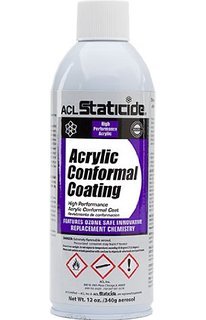Comparing AR to UR Conformal Coating
Posted by Sean Horn
Friday, May 27, 2016 7:30
@ 7:30 AM
Acrylic (AR) and polyurethane (UR) conformal coatings are among the best known and most commonly used conformal coating materials. As liquid coatings, both can be applied to substrates through a variety of methods:
- Brushing the substance onto the substrate surface.
- Dipping properly masked components into vats of coating material.
- Atomized/non-atomized spraying procedures, using either human or robotic labor.
However, sharing basic application techniques and some product end uses does not mean they can be applied interchangeably. Significant differences need to be addressed prior to determining how appropriate either conformal coating is for use with any particular project.
Basic Properties of AR and UR
 Understanding the fundamental differences between AR and UR is essential to their effective use.
Understanding the fundamental differences between AR and UR is essential to their effective use.
- Acrylic: Protecting electronics from corrosion, dirt, dust, fungus, moisture, and thermal shocks, AR conformal films also possess dielectric properties capable of withstanding most static/voltage discharge. With a dielectric strength of V 300/Mil., a dielectric constant of 2.5, and a dissipation factor of 0.01, ARs’ effective operating temperatures range from -65’C through +125’C. Following application – usually via liquid brush or spray methods – they dry quickly to a clear, salt-resistant conformal finish. Fluorescent levels are consistently high. While their abrasive/chemical resistance is commensurately low, AR coatings are rather easily applied, cleaned and removed; they are also useful for many component miniaturization and repair processes. Solvent-resistance is poor, but is good for acids and bases. These factors combine with moderate production costs to enhance acrylics’ popularity for many simpler conformal coating processes. Some grades of AR (e.g., Humiseal 1B31) are suitable for such specialized applications as Mil-I-46058C IPC-CC-830B. Typically, acrylic films vary from 0.002 to 0.005 inches thick after application. Curing time seldom exceeds 30 minutes, making acrylics the most viable option when a short turnaround time is required. AR is commonly used as moisture protection, conformally-coating printed circuit boards (PCBs).
- Urethane: Exceptionally resistant to abrasion and other forms of mechanical wear and corrosion, UR’s durable surfaces also offer diminished reversion potential. UR’s dielectric properties promote miniaturization because they insulate signal traces from circuits situated close together. With good moisture and chemical resistant qualities, UR is effective in operating environments where exposure to harsh chemicals is the rule. However, high levels of heat and/or vibration can distress UR conformal films and should be avoided. UR coatings are particularly valuable for their ability to combat ‘tin whiskers,’ the occurrence of crystalline, electrically-conductive tin-structures that can develop on assemblies whose final surface finish is composed of tin. Although whiskers seldom exceed several millimeters, the condition is especially problematic for electroplated tin finishes; they can cause electrical short-circuits for components following conformal coating. UR films are very effective at preventing their development, because they generate a coating sufficiently thick and strong to protect the assembly’s tin surface, while preventing additional structures from becoming a threat that could short-circuit the item.
Summary
Both AR and UR conformal coatings are applied to substrates by liquid processes, and frequently used for a variety of purposes. In many ways, similarities between them stop there.
For purposes of comparison, it should be noted the AR is quick-drying, emits minimal heat during cure (protecting the integrity of temperature-sensitive components), and achieves maximal physical properties in minutes. AR conformal films also:
- withstand humidity during component operation, resisting moisture-development within the assembly,
- do not shrink during operation,
- display low glass-transition temperatures,
- can be readily removed for repair by solvent-application to the region requiring attention,
- provide considerable post-application flexibility,
- fluoresce under UV light for simplified inspection, and
- are easily repaired, with the capacity to be soldered through if necessary.
Despite these advantages, AR can be easily removed with solvents, making it unsuitable for many coating purposes. Even weak solvents like isopropyl alcohol or xylene are sufficiently robust to remove AR from substrate surfaces. Moreover, assemblies subjected to operating temperatures greater than 125ºC are ill-served by AR coatings, which become quickly unserviceable. Also, their standard coating thicknesses — between .002 and .005 inches – are unsuitable for the microelectricalmechanical systems (MEMS) and nanotechnology (NT) uses becoming increasingly prevalent today.
Unlike AR, UR is much more impervious to solvents; its coating is exceptionally durable. Also, whereas AR can be completely cured in as few as 30 minutes, a full UR-cure usually requires at least several hours; some UR-types need 30 days at room temperatures to cure appropriately. Most varieties of UR provide conformal coatings supporting reliable inspection, with neither fluorescent nor free isocyanate content. UR films fight tin whisker growth very well, while delivering excellent humidity and chemical resistance, displaying dependable dielectric properties over extended durations.
However, its high solvent resistance makes UR difficult to remove or rework. While it can be removed with chemicals, this resistance can also mandate introduction of mechanical reworking techniques.to complete the task, increasing production downtime. UR also doesn’t perform effectively in high-vibration or high-heat environments. Most urethanes lose coating effectiveness at temperatures in excess of 125°C, limiting coating applications.
Neither AR nor UR display the versatility of parylene conformal coatings, but are useful for specified product purposes. Similar coating decisions need to be made among parylene types, as well.
If you’re looking for AR or UR conformal coating services, look no further than the experts at Diamond-MT. We have over 30 years’ of experience providing high-quality coating services including removal, repair and rework. Contact us to day for more information about our services or to request a quote.
Comments
Homepage 4/17/2020. 10:17:10 AM
... [Trackback] [...] Informations on that Topic: blog.paryleneconformalcoating.com/whats-the-difference-between-potting-and-conformal-coating/ [...]

londondrugscanada.bigcartel.comlondon-drugs 4/17/2020. 10:17:10 AM
cialis uk https://londondrugscanada.bigcartel.com/london-drugs This is nicely expressed. !